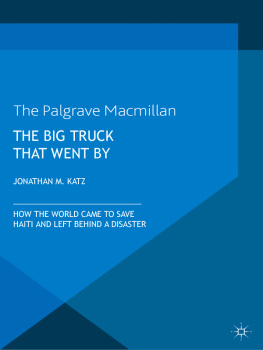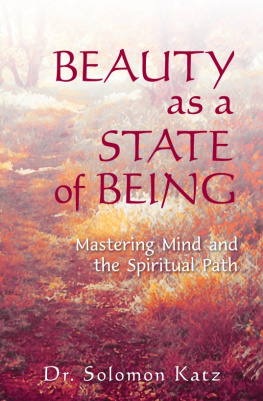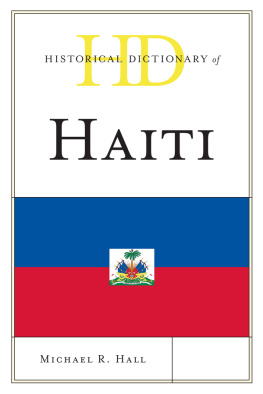ADDITIONAL PRAISE FOR THE BIG TRUCK THAT WENT BY
A top-notch account of Haitis recent history, including the January 2010 earthquake, from the only American reporter stationed in the country at the time. Katz broke the story of how the deadly cholera outbreak, which spread in the months after the earthquake, was brought to the region by infected Nepalese UN peacekeepers and spread by inadequate sanitation. In his debut, the author chronicles his many investigations during his years living in and writing about Haiti. Unlike coverage by other writers on the islands recent history, Katzs recounting of the earthquake disaster, and the international mobilization that followed, is part of an ongoing story.... His contacts and local knowledge gave him special insight into the way the relief operation developed.... An eye-opening, trailblazing expos.
Kirkus Reviews (starred)
Katz was the only American reporter on the ground when the devastating earthquake struck Haiti on January 12, 2010.... Debunks the assumption that a disaster leads to social disintegration or rioting and observes how media sensationalism prompted unwise giving.
Publishers Weekly
Beautifully written, brave, and riveting, The Big Truck That Went By tells the devastating story of the post-earthquake reconstruction effort in Haiti. Weaving together his personal experiences with the knowledge gained from his intensive investigative report, Katz offers us an autopsy of a global relief effort gone wrong. But the book also offers us a moving portrait of the courage, humor, and vision of the Haitians he worked with, offering a glimpse of the possibilities for a different future. Anyone seeking to understand Haitis current situation, as well as the broader impasses of our current model of aid, should read this book.
Laurent Dubois, author of Haiti: The Aftershocks of History
The horror of the catastrophic Haitian earthquake of 2010, the adrenaline rush of being a reporter in the middle of dramatic events, the frustration of watching local politicians and poorly informed outsiders combine to paralyze the recovery effort, and the joy of finding love in the midst of the ruins: Its all here. Katz, the only American journalist on the scene when the earthquake struck, gives us unique insights into the plight of a close neighbor whose fate is vitally connected to our own.
Jeremy Popkin, author of You Are All Free:
The Haitian Revolution and the Abolition of Slavery
Jonathan M. Katz has a passion for the truth. He has shown respect for the people of Haiti by seeking that truth throughout the earthquake and the aftermath.... This is an important book, and a page-turner!
Mark Doyle, BBC correspondent
Jonathan Katzs strength is his unique combination of heart, history, and solid reporting, brilliantly married in The Big Truck That Went By. Readers experience the country through his personal roadmap, one that is both sympathetic and yet sharply critical of all that could have gone right, but didnt.
Kathie Klarreich, author of Madame Dread:
A Tale of Love, Vodou, and Civil Strife in Haiti
THE BIG TRUCK
THAT WENT BY
THE BIG TRUCK
THAT WENT BY
HOW THE WORLD CAME TO SAVE HAITI AND LEFT BEHIND A DISASTER
JONATHAN M. KATZ

Quotations from conversations are either taken verbatim from recorded interviews or reconstructed from the authors contemporaneous notes. In certain cases, names and identifying characteristics have been changed.

THE BIG TRUCK THAT WENT BY
Copyright Jonathan M. Katz, 2013.
All rights reserved.
First published in 2013 by PALGRAVE MACMILLAN in the U.S.a division of St. Martins Press LLC, 175 Fifth Avenue, New York, NY 10010.
Where this book is distributed in the UK, Europe and the rest of the world, this is by Palgrave Macmillan, a division of Macmillan Publishers Limited, registered in England, company number 785998, of Houndmills, Basingstoke, Hampshire RG21 6XS.
Palgrave Macmillan is the global academic imprint of the above companies and has companies and representatives throughout the world.
Palgrave and Macmillan are registered trademarks in the United States, the United Kingdom, Europe and other countries.
ISBN: 978-0-230-34187-6
Library of Congress Cataloging-in-Publication Data is available from the Library of Congress.
A catalogue record of the book is available from the British Library.
Design by Letra Libre
All maps courtesy of Rick Orlosky. Reprinted with permission.
First edition: January 2013
10 9 8 7 6 5 4 3 2 1
Printed in the United States of America.
To Clide, Prince, Chris Owen Sanon, and a new generation in Haiti





INTRODUCTION
WHY HAITI? HILLARY RODHAM CLINTON ASKED IN EARLY 2010, SPEAKING on behalf of a bewildered world. The earthquake that leveled Port-au-Prince and much of southern Haiti had defied logic, imagination, even superstition. How did a magnitude 7.0 temblora huge release of energy, but not necessarily catastrophicprove to be the deadliest natural disaster ever recorded in the Western Hemisphere? Why did an earthquake, of all calamities, strike at the heart of a nation already reeling from so many others? And why, three years after so many countries and ordinary people sent money and help, hasnt Haiti gotten better?
I wrote this book in part to answer those questions. When the earthquake struck, I had been living in Haiti for two and a half years. I had already seen a lifetimes worth of disasters, both political and natural. Two centuries of turmoil and foreign meddling had left a Haitian state so anemic it couldnt even count how many citizens it had. Millions were packed in and around the nations capital, living in poorly made buildings stacked atop a fault line. People could not rely on police, a fire department, or schools. Even the rat-infested General Hospital charged so much for basic medicine that few Haitians could afford care. Nearly everythingwater, gas for generators, hungry relatives from the countrysidewas delivered by truck. Each day, big eighteen-wheelers rumbled down the narrow streets, shaking homes as they passed. When the shockwave surged through Port-au-Prince, just fifteen miles from the epicenter, many of us thought at first that it was a gwo machin, a big truck, going by.
But today, Haiti is not better off. It ended its year of earthquakes with three new crises: nearly a million people still homeless; political riots fueled by frustration over the stalled reconstruction; and the worst cholera epidemic in recent history, likely caused by the very UN soldiers sent to Haiti to protect its people (that story, and my investigation, appear later in the book). Those few who were fortunate enough to leave post-quake campsan estimated 400,000 still lived under tarps as of mid-2012usually settled in houses no safer than the ones that collapsed in the earthquake. Though by the time you read this book, the ruins of the devastated National Palace might finally have been cleared, rubble, some mixed with human remains, still chokes much of the city. At last count, more than half the reconstruction money that was supposed to be delivered as of 2011 remains an unfulfilled promise. For many of my Haitian friends, some of whom youll meet in this book, the legacy of the response has been a sense of betrayal.
Next page














